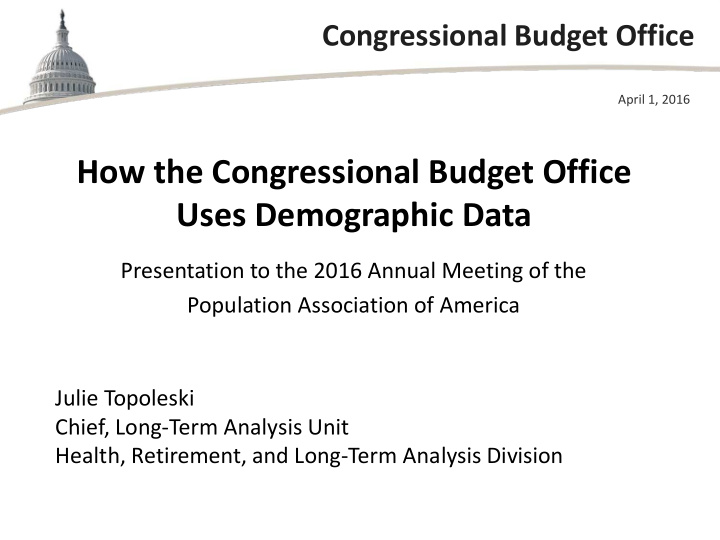



Congressional Budget Office April 1, 2016 How the Congressional Budget Office Uses Demographic Data Presentation to the 2016 Annual Meeting of the Population Association of America Julie Topoleski Chief, Long-Term Analysis Unit Health, Retirement, and Long-Term Analysis Division
What Does the Congressional Budget Office Do? ■ Since 1975, CBO has produced independent analyses of budgetary and economic issues to support the Congressional budget process. ■ Some of CBO’s products are the following: – Baseline budget and economic projections – Long-term budget projections – Cost estimates – Analytic reports – Budget options – Analyses of federal mandates 1 CONGRESSIONAL BUDGET OFFICE
How Does CBO Use Demographic Data? ■ Demographic data underlie CBO’s budget and economic projections and some cost estimates for legislation . ■ The size and composition of the U.S. population in coming decades will affect federal tax revenues and spending as well as the overall performance of the economy. ■ Demographic changes will influence the size of the labor force and the number of beneficiaries of such federal programs as Medicare and Social Security. ■ Population projections include estimates of rates of fertility, immigration, and mortality. 2 CONGRESSIONAL BUDGET OFFICE
What Sources of Demographic Data Does CBO Use? ■ Survey data – Current Population Survey – Survey of Income and Program Participation – Health and Retirement Study – American Community Survey – Medicare Current Beneficiary Survey – Medical Expenditure Panel Survey ■ Administrative data – Social Security administrative data – Medicare and Medicaid administrative data – Internal Revenue Service (IRS) data ■ Other demographic research 3 CONGRESSIONAL BUDGET OFFICE
CBO Has Used Demographic Data in Many of Its Estimates ■ Savings from an increase in the full retirement age for Social Security ■ Federal subsidies for health insurance coverage for people under age 65 ■ The impact of changes in federal immigration policy 4 CONGRESSIONAL BUDGET OFFICE
Estimating Savings From an Increase in the Full Retirement Age for Social Security ■ CBO has estimated the impact of increasing the full retirement age to 68 or to 70. ■ CBO uses individual-level data provided by the Social Security Administration on the number of workers with sufficient work histories from age 62 to the full retirement age. ■ CBO’s analysis reflects a study of the benefit claiming behavior of current Social Security beneficiaries as well as a study of the characteristics of workers claiming Social Security benefits at different ages. 5 CONGRESSIONAL BUDGET OFFICE
Estimating Savings From an Increase in the Full Retirement Age for Social Security (Continued) ■ CBO’s analysis used Social Security administrative data matched with survey data. ■ A worker’s characteristics can affect the benefit he or she receives. 6 CONGRESSIONAL BUDGET OFFICE
Estimating Federal Subsidies for Health Insurance Coverage for People Under Age 65 ■ Projections of the number of people enrolled in health insurance marketplaces and Medicaid require data on family structure, income, and sources of insurance coverage, including information on whether individuals have access to an offer of employment-based coverage. 7 CONGRESSIONAL BUDGET OFFICE
Estimating Federal Subsidies for Health Insurance Coverage for People Under Age 65 (Continued) ■ CBO uses data from the Survey of Income and Program Participation that are benchmarked to administrative data sources, including income data from the IRS and enrollment data for Medicaid and the health insurance marketplaces from the Centers for Medicare & Medicaid Services. ■ Premiums in the health insurance marketplaces are projected, in part, on the basis of data on historical trends in private health insurance premiums. 8 CONGRESSIONAL BUDGET OFFICE
Estimating the Impact of Changes in Federal Immigration Policy ■ Depending on the details of proposed legislation, changes to immigration policy could have a significant effect on the size and composition of the noncitizen population and, as a result, on rates of participation in federal programs and the payment of taxes. ■ When estimating the budgetary effects of proposals, CBO considers the demographic and labor force characteristics of foreign-born people, their eligibility for and participation in federal programs, changes in the economy, and a number of other factors. 9 CONGRESSIONAL BUDGET OFFICE
Estimating the Impact of Changes in Federal Immigration Policy (Continued) ■ CBO uses different types of demographic data as inputs to its projections. – Numbers of people in each of the noncitizen categories – Age and sex distribution – Marital status and fertility – Educational attainment and labor force characteristics – Income and earnings 10 CONGRESSIONAL BUDGET OFFICE
Estimating the Impact of Changes in Federal Immigration Policy (Continued) ■ Noncitizens include lawful permanent residents, temporary residents and visitors, and unauthorized residents. ■ They differ from both foreign- and native-born citizens across several demographic dimensions, especially in skills and employment status. – Noncitizens are much more likely to be of working age (between 25 and 64 years old) and much less likely to be 65 years old or older. – Noncitizens are significantly more likely than citizens to have less than a high school diploma or GED but about as likely to have a master’s or more advanced degree, reflecting a broad spectrum of education and skills. 11 CONGRESSIONAL BUDGET OFFICE
Related CBO Reports ■ Federal Subsidies for Health Insurance Coverage for People Under Age 65: 2016 to 2026 (March 2016), www.cbo.gov/publication/51385. ■ Social Security Policy Options, 2015 (December 2015), www.cbo.gov/publication/51011. ■ An Introduction to the Congressional Budget Office (July 2015), www.cbo.gov/about/overview. ■ How Changes in Immigration Policy Might Affect the Federal Budget (January 2015), www.cbo.gov/publication/49868. 12 CONGRESSIONAL BUDGET OFFICE
Recommend
More recommend